Vegetable pests range from caterpillars to beetles to slugs and snails. How can we gardeners combat the barrage of insect and animal pests that fight for control of our gardens each year? What is the best way of managing these issues? Well, I am here to tell you that we can only do this together.
While most of my time during the growing season is spent taking care of other people’s landscapes and gardens, I do find time to work in my own. And I have learned a lot. There are a lot of problems! But many have easy, simple fixes.
This list by no means completes the insect variety that can happen in the garden, but many of these you will come across in your vegetable garden each year. There are both specialist pests and generalist pests. The specialists feed on a certain group of plants, while the generalists eat everything.
Generalist Vegetable Pests
Most gardeners may not realize that many of are most annoying pests are a problem because they feed on everything. There are a number of generalist vegetable pests in the garden, and they go after both flowers and vegetables. To understand how to manage them, you must know what they are and what they do.
Slugs & Snails

I put these two together because their feeding damage is similar and the management practices are the same for both. As cool as it is for my children to see snails crawling around their arms, I would rather not see them at all. Growing up in North Central Kansas, I do not recall ever seeing a snail, but out here they are everywhere it seems. And they love my gardens!
Neither slugs nor snails are true insects, but rather are mollusks, more closely related to octopi and clams than they are to insects. They produce slime trails that help them move along the ground and plant surfaces, because they do not have feet. They both see and smell with their eyeballs.
There many different recommendations for managing slugs and snails in the garden. The most efficient way to combat slug and snail problems is with natural enemies. I am a big supporter of natural ecosystem management, and allowing nature to help in the garden is a benefit.
Wildlife as a Control for Slugs and Snails
Small snakes are the biggest eaters of slugs and snails in my garden. These include garter snakes, ringneck snakes, worm snakes, and Dekay’s brown snake, among others. Snakes like these are my best “garden buddies” and promoting them is easy. By leaving brush piles, and natural landscapes around my unnaturally landscaped areas, there are places for snakes to hide.
Another helpful animal in the garden is the duck. My wife and I recently started raising ducks as a means for eggs and insect control. While chickens are nice egg layer too, they have to be reined-in in the garden or they will eat the plants and the bugs. Our ducks primarily eat bugs, insects, and snails, while leaving the foliage alone.
Other Controls for Slugs and Snails
I have not personally tried the beer trap for slugs and snails. It may work, but the whole method sound inefficient and time-consuming. Another way to help control slugs and snails, and will work on other crawling insects as well is diatomaceous earth (DE). DE is made up of miniscule particles of silica from fossilized diatoms and sea creatures. It is naturally occurring. DE has very sharp edges to an insect or mollusk, and will literally rip apart the insides of slugs and snails.
Grasshoppers
You have all heard about the plagues of locusts in the Bible, or the grasshopper plagues mentioned in Laura Ingalls Wilder’s story of On the Banks of Plum Creek. Grasshoppers and locusts are primarily the same insect. They have stout bodies and long legs for jumping. They can fly well and far.

Grasshoppers are perhaps one of the most annoying generalist feeders. They would eat everything if there were enough of them. Keeping them out of the garden is difficult, but not impossible. Again, attracting snakes or having foraging ducks or geese can help control grasshoppers. Another method that can be helpful is to have a garden cat or dog. I had a cat once that would bring me dead grasshoppers before eating them.
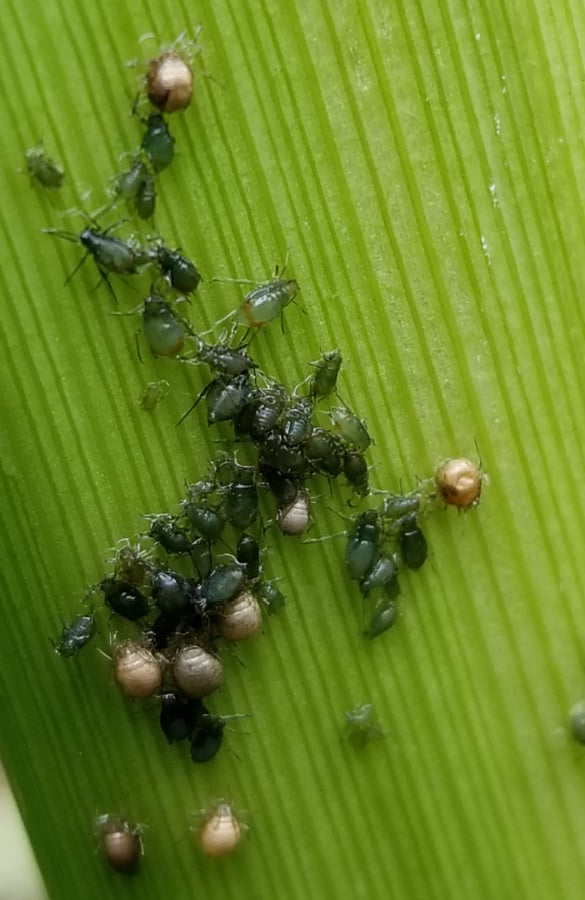
If you love fishing, collecting grasshoppers for bait is an excellent choice. My kids and I like to catch grasshoppers and throw them into a neighbor’s pond to watch the fish come up for them.
Aphids
These soft-bodied insects can multiply very quickly if left untreated. While there are many different species of aphids, many will also feed on a variety of vegetables. Controlling aphids quickly will keep secondary pests and diseases from becoming a problem.
The best methods for managing aphids are 2-part. First, attract beneficial insects to the garden by following a potager garden approach with flowers and herbs intermingled with vegetables. Second, be ready for explosive populations with a good hand sprayer filled with 1 tsp dish soap to 1 gallon of water. If aphid populations explode beyond the upkeep of natural predators like lady beetles, lacewings, hover flies, and parasitoid wasps, you may need to help yourself with a soapy spray.
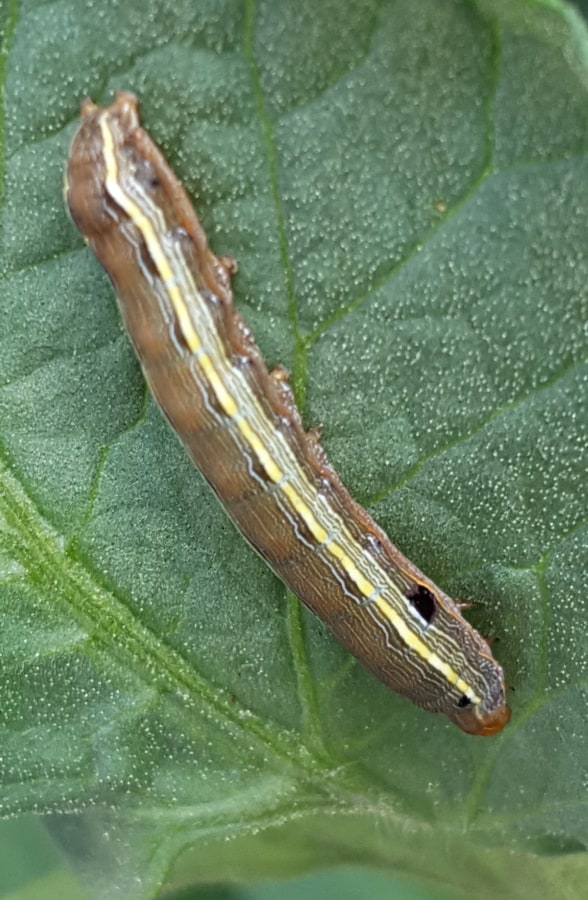
Armyworms
The armyworm caterpillar is quite happy feeding on a range of vegetable and flower hosts. However, I have found them to be most detrimental to my tomatoes. And I love my tomatoes. Ridding yourself of armyworms in no small matter, unless you leave it to the professionals-insects.
By attracting beneficials such as tiger beetles, soldier bugs, spined soldier bugs, and parasitoid wasps, you can kill many of the armyworms that you do not even see. Hand-picking is another easy way to control armyworms, as well as other, similar caterpillars on vegetables. Drop the caterpillars into a bucket of soapy water, or take them to your chickens (if you have chickens) and watch them fight over them.
Specialist Vegetable Pests
There are a lot of insects that feed primarily on different groups of vegetables. While some the controls are the same, each insect needs to be recognized and viewed closely so we can see what control is best. Let us break these vegetables pests down by the plant families they attack.
Vegetable Pests of Nightshades
What are nightshades? Nightshades include peppers, tomatoes, potatoes, eggplant, and tomatillos. There also many wild nightshades growing along roadsides and in pastures and meadows. I like to use the wild growing nightshades as a trap crop for some of the vegetable pests.
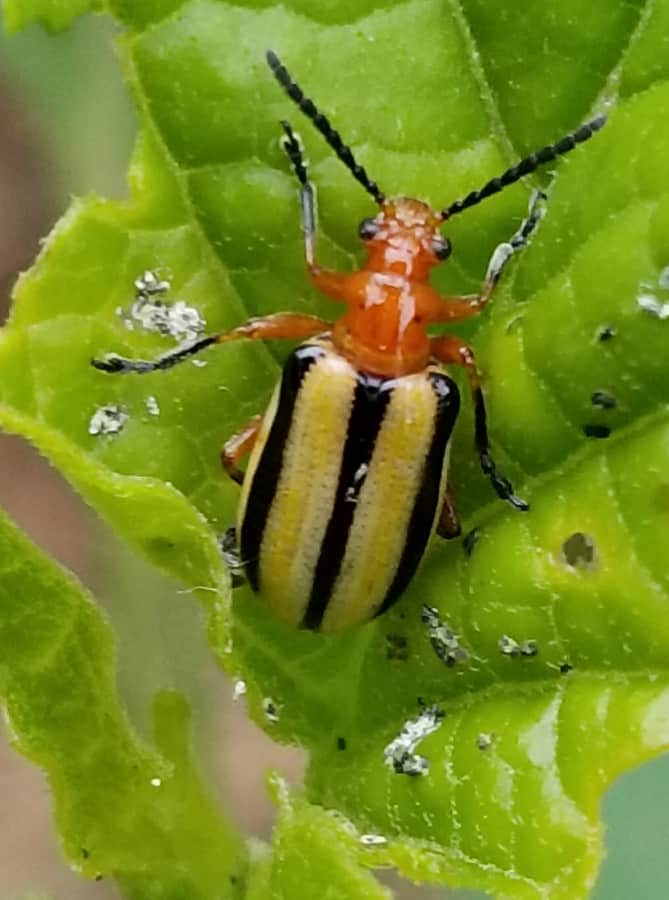
Potato Beetles
There are 3 species of “potato” beetles that we need to be concerned with: the Colorado potato beetle, the false Colorado potato beetle, and the 3-lined potato beetle. Each of these beetles feed primarily on nightshades, though the 3-lined potato beetle feeds mostly on tomatillos. All of them can be quite devastating to a crop. Both the adult beetles and the immature grubs feed on the leaves, flowers, and stems of nightshade vegetables.
Natural enemies of these beetles include spined soldier beetles, parasitoid wasps, and parasitoid nematodes. If you use buffalo-bur as a trap crop, the Colorado potato beetle will flock there first, and you can apply a pesticide to kill the adult beetles and grubs. An application of Btsd (Bacillus thuringiensis, var. san diego), will kill the grubs as they eat it, without hurting natural enemies.
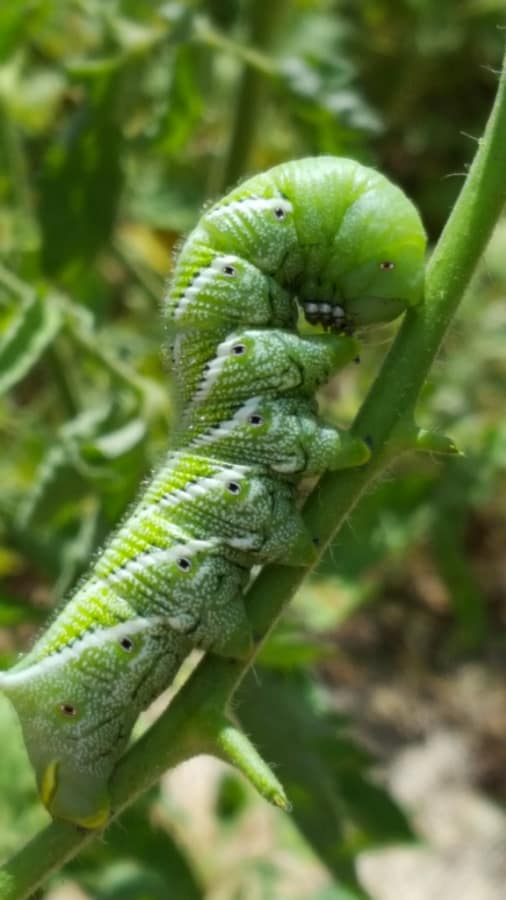
Tobacco Hornworm & Tomato Fruitworm
Neither of these are worms, but rather caterpillars of a moth. They are different moths, but because they are both moths, their treatment is similar. The tobacco hornworm is a large, voracious eater of the whole tomato plant, from fruit to flower. It is a sphinx moth caterpillar and has a “horn” on its rear end.
The tomato fruit worm is the same insect that feeds on the corn, known as the corn earworm. I do not call this moth a generalist, because it really only feeds on 2 vegetable garden plants: tomatoes and corn.
Both of the the above caterpillars can be treated in similar manners. By attracting natural enemies, such as parasitoid wasps, you can kill off most of the caterpillars while they are feeding, but before they can pupate. Caterpillars can also be handpicked to feed to chickens/ducks or dumped into a pail of soapy water. Or just drop them onto a board and squish them.
Blister Beetles

While it is true that blister beetles can feed on a variety of perennials, annuals, and vegetables; here in the central Great Plains they mainly attack nightshades in the vegetable garden. They are worst for me on tomatoes, once they have moved off my hostas in the shade garden.
Blister beetles come in a wide array of colors, from striped brown to solid gray or black. They emit an irritant when handled or bothered, that can raise blisters or welts on susceptible people. These beetles can be difficult to eradicate.
I have found the best treatment for keeping blister beetle populations down is to gently brush them off the plant into a bucket of soapy water. They are dead within a few minutes. The best time of day to do this is in the evening, about dusk.
Vegetable Pests of Cucurbits
Cucurbits include things like squash, watermelon, cucumber, pumpkin, gourd, and melons. There are a variety of pests that attack these common vegetables.
Squash Bugs
These annoying bugs are perhaps one the vegetable gardener’s biggest nightmares. It seems as if all you have to do is whisper “I am planting squash” and all the squash bugs for miles come and park in your garden.
I have written a previous post on these bugs that will answer all the questions about how to remove them. See Controlling Squash Bugs in the Garden
Cucumber Beetles
There are both spotted and striped cucumber beetles, adding to the confusion of beetles in the vegetable garden. Both attack members of the cucurbits, and both can vector diseases, such as bacterial wilt, which is deadly for cucurbits.


To control these beetles, plant varieties that are resistant first to bacterial wilt, and second to the beetle itself. Applying diatomaceous earth (DE) around the plants on both the plants and soil will help control these beetles. Applications of DE will have to be reapplied after rain or a heavy dew. If watering an area where you need to use DE, switch to drip instead of soakers or sprinklers.
Squash Vine Borer
This moth likes to lay its eggs near the base of the vine of cucurbits, mainly squash and pumpkin. After the eggs hatch, the borer feeds in the stem of the plant, causing it too wilt and collapse.
Though time consuming, there is a tried and true method for preventing this moth’s damage. Take a piece of foil and wrap the stem of the vine around from the ground to the first set of true leaves. This has never failed me.
Vegetable Pests of Brassicas
But what are brassicas? These are vegetables such as cabbage, cauliflower, broccoli, kale, and kohlrabi. Pests of most of these vegetables can be prevented with a simple floating row cover. If you choose not to use this simple tool, you will have problems.
Cabbage Looper, Cabbage White, & Cross-Striped Cabbage Worm
All of these are caterpillars. The cabbage white is a butterfly, but the other two are moths. These caterpillars are messy, quick eaters. Consuming leaf matter quickly, they leave behind lots of poop. I have heard horror stories of cabbage worms on prized cabbages because gardeners decided not to use the simplest tool-the floating row cover.
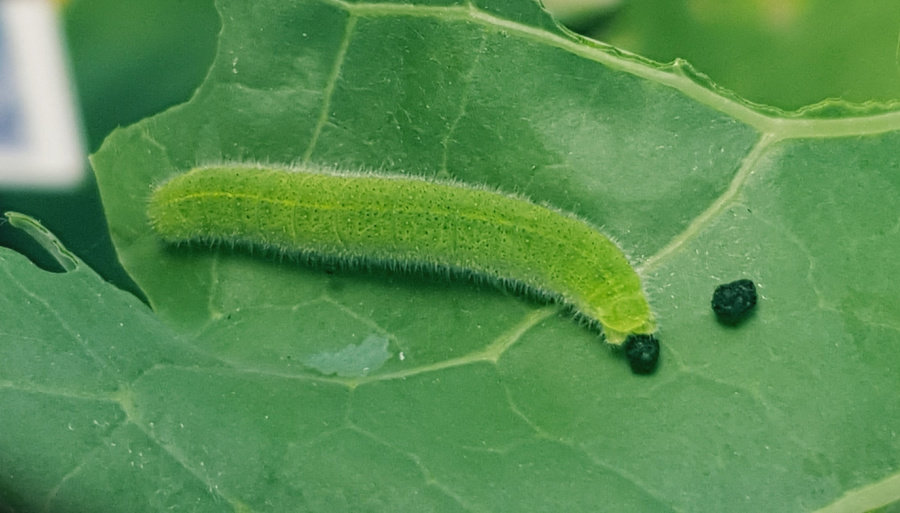
Floating row covers are the only way to go if you ask, when it comes to growing cabbage, broccoli, and cauliflower. Diatomaceous earth works, but it needs reapplied after rain and it makes the plants look messy. Floating row covers allow in air, light, and rain, all while keeping out moths wanting to lay eggs.
Harlequin Bugs
These pesky, yet unique looking shield bugs attack a variety of brassicas and other cruciferous vegetables. I have seen them only on brassicas here in Northeast Kansas, though they can feed on a variety of crops.

The key to success against harlequin bugs is crop rotation and floating row covers. If the bug cannot get to the plant, then is cannot suck the life out of it. Harlequin bugs feed by sucking plant juices, which weakens the plant and allows for secondary pests and diseases to take over. Because the bug overwinter as adults, it is important to rotate plantings of brassicas from one bed to another. Then use a floating row cover to prevent emerging adults from getting to the crop.
Vegetable Pests of Corn

Corn is one of America’s biggest crops and it is also one the gardener’s favorite to grow. Who does not dream of eating fresh ears of sweet corn by Independence Day?
Corn Earworm
As I mentioned above, the corn earworm is the same moth species as the tomato fruit worm. On corn, the earworm feeds primarily near the silk end of the ear. The moth lays an egg at the silk end of the ear and the hatched caterpillar eats its way into the ear to feed on the developing kernals.
For the most part, there are few organic solutions to controlling this pest. There are no good cultural controls, except ones that take too much time. I have not seen enough damage on my own corn crops to recommend treating with chemicals or growing GE corn. Let the worms have a bite, then feed them to the chickens when cutting the corn.
European Corn Borer
This pest from Europe can be a major player when growing even small plots of corn in a garden setting. The moth lays a mass of eggs on the underside of leaves, which then hatch and feed on the leaves, stalks, and ears of the corn. The worst damage is on the ears, as they feed throughout the ear.
Garden rotation and fall cleanup are the best ways of preventing ECB from overwintering. They overwinter as pupae in the stalks, so cut the stalks at ground level and remove to a burn pile. Corn stalks do not compost well, so this is a better way to handle the stalks. If you are somewhere than cannot burn, such as in city limits, remove chopped corn stalks to the trash.
If you feel the need to use chemicals to prevent or stop an infestation of ECB, use Btk (Bacillus thuringiensis kurstaki) which is formulated best for ECB.
Other Specialist Vegetable Pests

There is an insect pest for everything!
Bean Leaf Beetles
There are a variety of beetles that attack mainly beans, though they do go after other plants as well. Both the Mexican bean beetle and bean leaf beetles can cause significant damage to beans, both pole and bush beans.
Prevention is key to keeping your bean plants healthy and thriving. Because these beetles are fair fliers, it is best to apply a layer of DE over the whole area, both on the plants and on the ground below. If you are able to do so, use floating row covers on your bush beans to prevent damage.
Common Asparagus Beetle
The asparagus beetle feeds on everyone’s favorite perennial vegetable. These slender beetles lay eggs near the top of emerging asparagus shoots, and feed there after hatching. Garden cleanup is perhaps the best remedy for preventing these beetles.
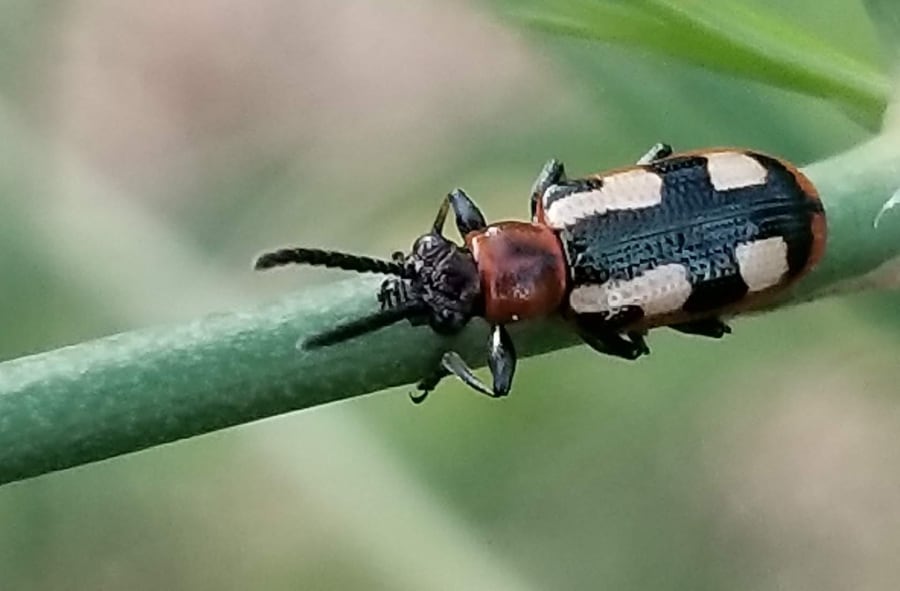
After the ferns have turned brown in autumn, cut or mow them off and burn them. In the spring, just as new spears are emerging, apply a layer of DE and re-apply after rain and stop after harvest is finished.
Flea Beetles
These smaller beetles are so named because of their habit of jumping like fleas when disturbed. they are most common on spinach, chard, eggplant, and various greens such as lettuce, kale, and mustard. Their feeding causes “shot-holes” throughout the leaf surface. Floating row covers and DE can help prevent flea beetles from gaining access to the plants.
The Organic Gardener’s Arsenal for Controlling Vegetable Pests
Now that you know the pests and what to do about them, let us go over the best organic practices mentioned above for preventing or controlling vegetable pests.
Crop Rotation
Being able to rotate your vegetable crops from one end of the garden space to another will greatly reduce the amount of pest problems that would otherwise arise. Since many of our biggest vegetable pests overwinter in debris and soil, moving the crop in the next season makes perfect sense.
If you are gardening in your small backyard, or in patio pots, or in just a few raised beds, crop rotation may not be possible. Just make sure to clean up all debris and dead materials from the garden in the fall to prevent overwintering pests.
Floating Row Covers
I have mentioned these a lot above. The floating row cover is perhaps the most valuable tool a gardener can have. You can prevent a large number of pests over an arrangement of crops with these covers. They are easy to use, and let in both light and water, while keeping pests out.
Diatomaceous Earth
I talk a lot about the use of this organic pesticide? It is a pesticide, though there are many more applications for it than use as a killer of insects. However, in the garden is it indispensable in its use as a weapon against all manner of insects.
Garden Cleanup
If you are waiting for spring to clean up the garden because you want beneficials to overwinter safely, then you are hurting your own cause more than helping it. While it is true that beneficials overwinter in landscape debris and natural habitats, there are few that overwinter in vegetable garden debris.
Most of the garden debris, except corn stalks and diseased plants can be composted. Diseased plant material should be added to a burn pile or barrel, or sent out in the trash. Corn stalks and leaves should be burned or trashed.
Conclusion
Keeping the garden free of vegetable pests can seem quite challenging for first time gardeners, but it is also rewarded with a bountiful harvest of yummy veggies. Keep up the work, and the garden will reward.
Happy planting!




